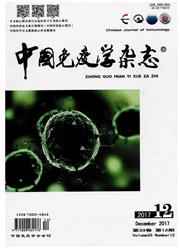

 中文摘要:
中文摘要:
目的:构建中国旱獭去唾液酸糖蛋白受体(ASGPR)H1和H2亚基糖基识别域(CRD)的原核表达质粒,体外表达纯化后制备多克隆抗体。方法:RT-PCR扩增出中国旱獭肝组织中ASGPR CRDH1和CRDH2 cDNA,将其克隆至原核表达载体pRSET-B中,在大肠杆菌BL21(DE3)pLysS内诱导表达。用纯化的重组蛋白免疫BALB/c小鼠制备多克隆抗体,并采用酶联免疫吸附试验、Western blot及免疫组织化学检测抗体的灵敏度和特异性。结果:成功构建了中国旱獭去唾液酸糖蛋白受体H1和H2亚基糖基识别域原核表达质粒pRSET-B.CRDH1和pRSET-B.CRDH2,目的蛋白可以高效表达,用其免疫BALB/c小鼠获得了高效价的特异性多克隆抗体。结论:首次成功表达了中国旱獭去唾液酸糖蛋白受体H1和H2亚基糖基识别域多肽,且纯度高,免疫原性强,用其免疫小鼠获得的多克隆抗体特异性好、效价高,为在HBV感染模型-中国旱獭体内进行肝脏疾病的靶向治疗奠定了实验基础。
 英文摘要:
英文摘要:
Objective:To construct the prokaryotic plasmids expressing the carbohydrate recognition domain(CRD) of the H1 and H2 subunits of asialoglycoprotein receptor(ASGPR) of Marmota himalayan, express and purify the recombinant proteins, develop the polyclonal antibodies against the CRDH1 or CRDH2 of ASGPR. Methods:ASGPR CRDH1 or CRDH2 was amplified by RT-PCR from the liver of Marmota himalayan and cloned into prokaryotic expression vector pRSET-B, then expressed in E. eoli BI221 (DE3) pLysS. The recombinant proteins were purified using Ni^2+ -NTA spin column. Polyclonal antibodies were developed by inoculating BALB/e mice with the purified recombinant proteins. And the sensitivity and specificity of the antibodies were evaluated by enzymelinked immunosorbent assay (ELISA), immunohistochemical staining( IHC ) and Western,blot analysis. Results:The pRSET-B. C RDH1 and pRSET-B. CRDH2 prokaryotic expression plasmids were constructed. The recombinant proteins were expressed and purified successfully. The high titer polyclonal antibodies with high specificity were obtained by immunizing BALB/c mice with the purified recombinant protein. Conclusion:The first published recombinant CRDH1 and CRDH2 of ASGPR of Marmota himalayan are highly purified with strong antigenecity. The polyclonal antibody against the recombinant proteins are obtained by regular immunization method, showing both high sensitivity and specificity. The recombinant proteins and antibodies can be used for targeting gene therapy in a new animal model of HBV infected- Marmota himalayan.
 同期刊论文项目
同期刊论文项目
 同项目期刊论文
同项目期刊论文
 期刊信息
期刊信息
